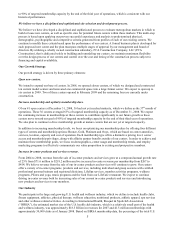Lifetime Fitness 2008 Annual Report Download - page 21
Download and view the complete annual report
Please find page 21 of the 2008 Lifetime Fitness annual report below. You can navigate through the pages in the report by either clicking on the pages listed below, or by using the keyword search tool below to find specific information within the annual report.15
Item 1A. Risk Factors.
We may be unable to attract and retain members, which could have a negative effect on our business.
The success of our business depends on our ability to attract and retain members, and we cannot assure you that we
will be successful in our marketing efforts or that the membership levels at our centers will not materially decline,
especially at those centers that have been in operation for an extended period of time. All of our members can cancel
their membership at any time upon providing advance notice. In addition, we experience attrition and must
continually attract new members in order to maintain our membership levels and sales from in-center services. There
are numerous factors that could lead to a decline in membership levels or sales of in-center services that could
prevent us from increasing membership at newer centers where membership is generally not yet at a targeted
capacity, including changes in discretionary spending trends and general economic conditions, market maturity or
saturation, a decline in our ability to deliver quality service at a competitive price, direct and indirect competition in
the areas where our centers are located and a decline in the public’s interest in health and fitness. In order to increase
membership levels, we may from time to time offer lower membership rates. Any decrease in our average dues,
reduction in enrollment fees or higher membership acquisition costs may adversely impact our operating margins.
Our debt levels may limit our ability to access additional funds under our existing credit facilities and limit our
flexibility in obtaining additional financing to pursue our growth strategy and other business opportunities.
As of December 31, 2008, we had total consolidated indebtedness of $712.9 million, of which $323.8 million was
floating rate debt, consisting principally of obligations under term notes that are secured by certain of our properties,
borrowings under our revolving credit facility that are secured by certain personal property, mortgage notes that are
secured by certain of our centers and obligations under capital leases.
Our level of indebtedness could have important consequences to us, including the following:
x our ability to obtain additional financing, if necessary, for capital expenditures, working capital, acquisitions
or other purposes may be impaired or such financing may not be available on favorable terms;
x we will need a substantial portion of our cash flow to pay the principal of, and interest on, our indebtedness,
including indebtedness that we may incur in the future;
x payments on our indebtedness will reduce the funds that would otherwise be available for our operations and
future business opportunities;
x a substantial decrease in our cash flows from operations or a substantial increase in our investment in new
centers could make it difficult for us to meet our debt service requirements and force us to modify our
operations;
x we may be more highly leveraged than our competitors, which may place us at a competitive disadvantage;
x our debt level may make us more vulnerable and less flexible than our competitors to a downturn in our
business or the economy in general; and
x some of our debt has a variable rate of interest, which increases our vulnerability to interest rate fluctuations.
In addition to the amount of indebtedness outstanding as of December 31, 2008, we had access to an additional
$46.5 million under our credit facilities. We also have the ability to incur new debt, subject to limitations under our
existing credit facilities and in our debt financing agreements. If we incur additional debt, the risks associated with
our leverage, including our ability to service our debt, could intensify.
If we fail to comply with any of the covenants in our financing documents, we may not be able to access our
existing credit facilities, we may be required to pay increased interest and our obligations to repay our
indebtedness may be accelerated.
We have entered into several financing transactions to finance the development of our centers. Certain of the loan
documents contain financial and other covenants applicable to us, and certain of these loan documents contain cross-
default provisions. For example, we have 13 centers financed by Teachers Insurance and Annuity Association of
America (“TIAA”) that are subject to cross-default and cross-collateral provisions, which would allow the lender to
foreclose on each of these 13 centers if there is an event of default related to one or more of these centers. In
addition, any default or acceleration of payments under any loan facility of more than $1 million and any default that
results in termination of acceleration of payments under any lease transaction involving annual payments in excess
























